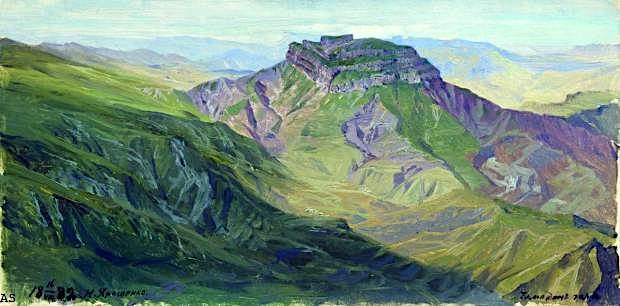NIKOLAI YAROSHENKO (1846-1898),
Gunib Mountain (1, 500m - 4,921ft)
Russia (Republic of Dagestan)
In Hora Dagestan, oil on can vas, 1888, Private collection
The mountain
Gunib Mountain (1, 500m - 4,921ft) dominates the village of Gunib (Гуниб) in Daghestan, chief town of the district of the same name. Its population, of stingy ethnicity, was 2 271 inhabitants in 2010. Gounib is situated in the middle of the Gounib Plateau, 172 kilometers southwest of Makhachkala at an altitude of 1,500 meters.
This area was taken by the Russian army against Shamil on August 25, 1859 who surrendered to General Prince Alexander Bariatinski. The village was formed in 1862 as a dwelling place for workers building a Russian fortress. It took the name of an aul higher on the plateau destroyed in 1859. Gounib was the chief town of Okrug Gounib belonging to the oblast of Dagestan (until 1921). The barracks of the Samur Regiment and the Artillery Regiment of the Dagestan Fortress and Terek were built there in 1895. At that time there were twenty-nine homes of employees, merchants, retired soldiers, a small Orthodox church and a post office.
The painter
Nikolai Alexandrovich Yaroshenko was born in the city of Poltava, Russian Empire (now Ukraine) to a son of an officer in the Russian Army. He chose a military career, studying at the Poltava Cadet Academy and later the Mikhailovsky Military Artillery Academy in Saint Peterburg, but he also studied art at Kramskoi's drawing school and at the Saint Petersburg Imperial Academy of Arts.
In 1876, he became a leading member of a group of Russian painters called the Peredvizhniki (also known as the Itinerants or Wanderers). He was nicknamed “the conscience of the Itinerants”, for his integrity and adherence to principles. Yaroshenko retired as a Major General in 1892. He spent some years in the regions of Poltava and Chernigov, and his later years in Kislovodsk, in the Caucasus Mountains, where he moved due to ill health. He died of phthisis (pulmonary tuberculosis) in Kislovodsk and was buried there.
Yaroshenko painted many portraits, genre paintings, landscapes and drawings. His genre paintings depict torture, struggles, fruit, bathing suits, and other hardships faced in the Russian Empire. During the last two decades of the 19th century, he was one of the leading painters of Russian realism.
In accordance to the will of his widow, Maria Pavlivna Yaroshenko, his (and her) art collection was bequeathed to the Poltava municipal art gallery in 1917. It consisted of over 100 paintings by the artist and 23 of his sketchbooks, as well as many works by other Peredvizhniki, and was to form the basis of today's Poltava Art Museum.
_______________________________
2021 - Wandering Vertexes...
by Francis Rousseau

